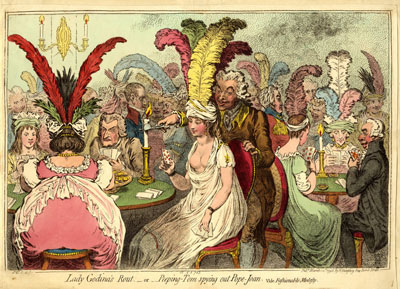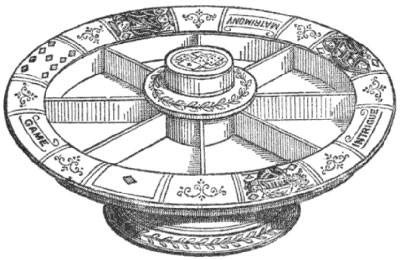Lady Godina's Rout, or Peeping-Tom Spying out Pope-Joan
This highly finished and beautifully designed print is just one of several published by Gillray in 1795/6 satirizing the huge plumes and revealing dresses of the British beau monde. Others include Ladies Dress As It Soon Will Be (1796), The Fashionable Mamma, or the Convenience of Modern Dress (1796), and Modern Elegance (1795).

[March 12, 1796]
© Trustees of the British Museum
The title and substance of the print allude to two legends and a card game well known at the time: the first legend concerns Lady Godiva and Peeping Tom; the second is the myth of, and subsequent card game called, Pope Joan.
According to the 13th century legend, the generous Lady Godiva had frequently complained to her husband, Leofric the Earl of Mercia, about the onerous taxes and consequent suffering he was inflicting on the good citizens of Coventry. Thinking to silence her once and for all, he said he would agree to relieve the citizens of that burden when she would agree to ride naked through the streets of the city. Taking him at his word, Lady Godiva agreed to ride through Coventry clad only in her long hair. But she issued a proclamation requesting that, on that day, the citizens would stay inside and close their windows to preserve her modesty. Not suprisingly, the ride has been frequently portrayed in later paintings with varying degrees of discretion. But in a later version of the story, (inevitably) there was someone, Tom the tailor, who could not resist peeping at Lady Godiva as she rode by. Hence the expression "Peeping Tom."
In Gillray's print, the bare-breasted young lady is "Lady Godina," a cross between the medieval Godiva and (per Joseph Grego's commentary) the young and attractive Lady Georgiana Gordon. The large-bottom lady seen from the back has somerimes been identified as Albinia Hobart, Countess of Buckinghamshire, Gillray's favorite fat lady. But given the setting it is more likely Jane Gordon, Duchess of Gordon, who was famous for her large and fashionable parties (routs) and for her skill in marrying off her daughters to titled English gentlemen. It is surely no accident that at her table, they are playing the card game of Pope Joan (described below) whose staking wheel includes compartments labeled "Intrigue" and "Matrimony." Georgiana is the literal center of attention of the print in at least two ways: her plunging neckline has already distracted the "Peeping Tom" who is supposed to be trimming the candles; and as described below, she is holding the nine of diamonds which is the Pope Joan card.
Pope Joan was reputed to be a learned and ambitions young woman of the 9th century who disguised herself as a man thus enabling her to move up the Catholic Church hierarchy to be elected Pope. Although almost certainly fictional, she was still talked about in Gillray's time as an example of one of the many horrors Catholicism invited. But Pope Joan was also the name of a card game requiring a special tray or wheel with eight compartments to hold counters. The compartments were labeled Ace, King, Queen, Jack, Game, Pope (9?), Matrimony (K Q of trumps) and Intrigue (Q J of trumps). From what I can glean (not being a card player myself) at the start of the game, counters are distributed in the compartments with the largest number going to the one labeled Pope. Then all but one of the cards are dealt to the players. The nine of diamonds is considered the Pope. The holder of that card can immediately claim all the counters in the Pope compartment, giving him or her a distinct edge in the game.

© Wikipedia
As is common in Gillray's later work, there are other caricature portraits among the card players at the two tables, but only a couple have been identified. The sole man at Godina's table is sometimes identified as Gillray's friend John Sneyd, but judging from the distinctive and radical V of his wig line, he is more likely John Nicholls who is featured in French Habits as Juge de Paix and in the New Pantheon of Democratic Mythology as Cupid and whose politics were better aligned with that of the Duchess.
Sources and Reading
- Commentary from the British Museum on Lady Godina's Rout, or Peeping-Tom Spying out Pope-Joan.
- Draper Hill, The Satirical Etchings of James Gillray, 1976, #40
- "Lady Godiva," Wikipedia
- "Georgiana Russell, Duchess of Bedford," Wikipedia
- "Jane Gordon, Duchess of Gordon," Wikipedia
- "Pope Joan," (reputed person) Wikipedia
- "Pope Joan (card game)," Wikipedia
- "Pope Joan The Curse of Scotland," Historic Card Games by David Partlett
- Thomas Wright and R.H. Evans, Historical and Descriptive Account of the Caricatures of James Gillray #416.
- Thomas Wright and Joseph Grego, The Works of James Gillray, the Caricaturist; With the History of His Life and Times, p. 210.
Comments & Corrections
NOTE: Comments and/or corrections are always appreciated. To make that easier, I have included a form below that you can use. I promise never to share any of the info provided without your express permission.